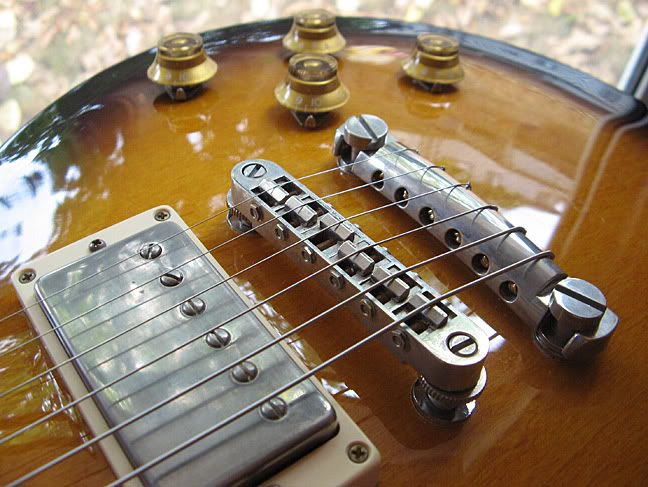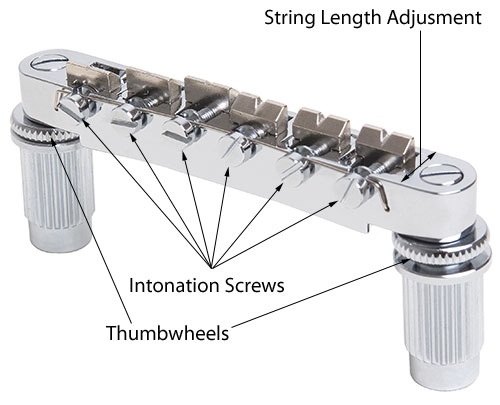The slammed stop bar myth and movement in Tune-O-Matic bridges
The slammed stop bar myth and movement in Tune-O-Matic bridges
by Terry Relph-Knight 27/02/18, copyright retained
This idea, that a screwed down stop tailpiece transfers vibration to the body and provides more sustain is an evil meme. It is perhaps something that some guitar journalist, who didn’t understand physics, wrote in some popular guitar magazine years ago and has been repeated mindlessly ever since.
For a start it is a contradiction – if the screwed down stop bar did provide a better mechanical coupling to the body then more of the string vibration would be adsorbed by the body resulting in LESS sustain. For sustain you want as much of your picking energy to remain in the string as long as possible. Bolting down the stop bar (and the bridge) reduces movement and lossy vibration in the components directly connected to the strings and that is why sustain may be affected.
Secondly the standard stop bar is not designed to be locked down. The design of the slots in the bar and the collars on the fixing bolts means that the stop bar is more or less equally coupled to the body no matter what height it is set at. To be able to couple the stop bar rigidly to the body you would need to use bolts without collars.
All the Gibson guitars that use a stop bar and an Advanced Bridge 1 or a ‘Nashville’ bridge (should probably be known as an ABR-2) derive from a guitar design using a trapeze tail piece. The stop bar, with its collared bolts, is actually designed to allow the string ends to be raised to approximately where they would be if a trapeze tailpiece was used, otherwise why would those bolts have collars?
If the stop bar is set as low to the body as it will go, over time there is so much pressure on the Tune-O-Matic bridges that they gradually start to collapse and bend in the middle.
Some guitarists recommend ‘top wrapping’ the strings, fitting the strings with the ball ends on the bridge side of the stop bar and then folding them back over the top of the bar. This method of installing the strings to the stop bar does allow the stop bar to be screwed down, while still providing a shallow break angle for the strings behind the bridge saddles. However, if the standard collared bolts are used, this method still does not lock the stop bar firmly to the body of the guitar and many people do not like the rough feel of the strings over the top of the stop bar, which over time will get scratched and grooved by the top wrapped strings.
So why top wrap, when you can use stop bar bolts without collars, fit spacers under the stop bar, and both lock the stop bar firmly in place and set it at the height it was always intended to be, which by the way reduces tuning problems by minimising string friction over the bridge saddles and doesn’t collapse the bridge.
If you are interested in this sort of stabilisation modification for your stop bar equipped guitar then please contact me via terry.relph@gmail.com or through an enquiry to the London Guitar Academy.
Slop in the Gibson style Tune-O-Matic ABR-1 and Nashville bridges
Like the standard Gibson style stop bar the Tune-O-Matic bridges rely on string tension for their mechanical stability and often have a degree of movement. The holes in the bridge have to be larger than the diameter of the support posts and the screw posts on the Nashville model are often not a tight fit in the threaded inserts into the top of the guitar.
Epiphone are to be applauded in their efforts in addressing this problem. Their solution, called ‘LockTone’, involves fitting small stainless steel leaf springs in the bridge holes and in the slots of the stop bar. This solution does not firmly lock the bridge or the stop bar in place, but even so Epiphone have published test results that they claim show improvements in sustain http://www.epiphone.com/News/Features/News/2011/Understanding-The-Epiphone-LockTone-Stopbar-Tune-o.aspx.
There are other solutions, from for example TonePros http://www.tonepros.com/ that will mechanically lock the bridge in place, improving sustain, tone and tuning stability.
tune o matic bridge setup, tune o matic bridge replacement, tune o matic bridge saddles, tune o matic bridge parts, tune-o-matic bridge saddle direction, tune o matic bridge intonation, tune o matic bridge installation, gibson nashville bridge vs abr-1, difference between abr-1 and nashville bridge, tune o matic bridge replacement, abr-1 bridge, best tune o matic bridge, tune o matic roller bridge, tune o matic bridge saddles


